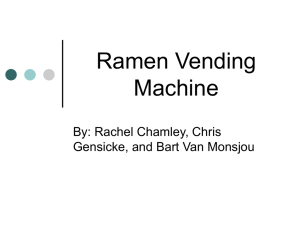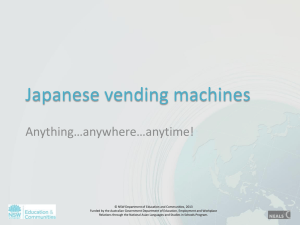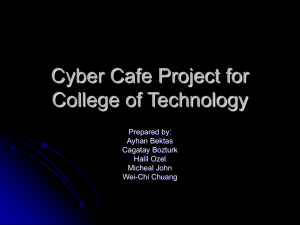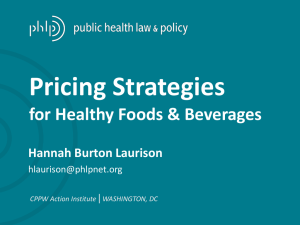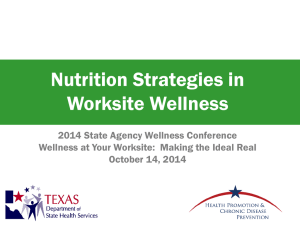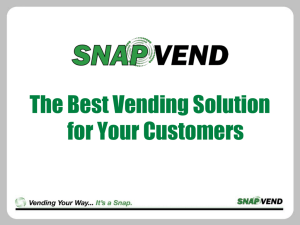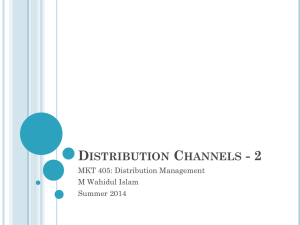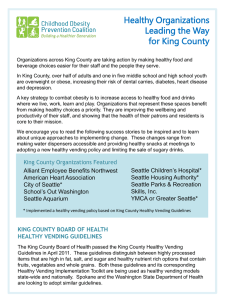Stephanie Freedman Helfman, MSPH
advertisement
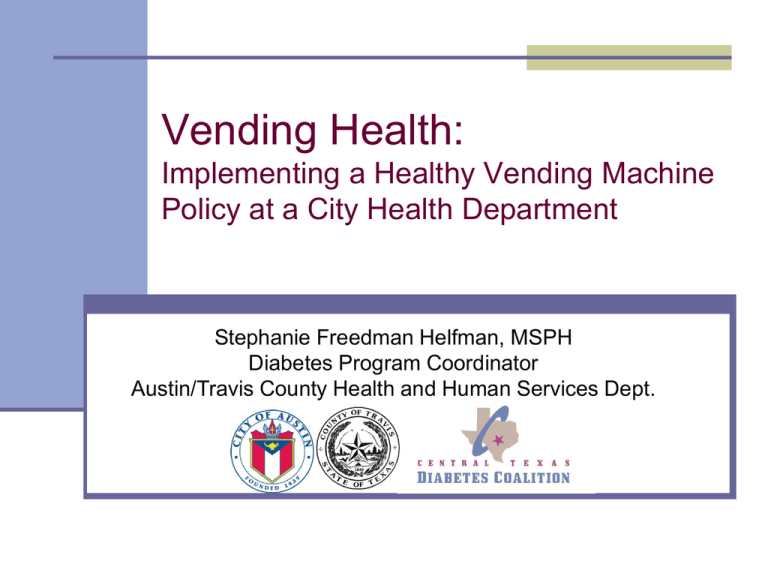
Vending Health: Implementing a Healthy Vending Machine Policy at a City Health Department Stephanie Freedman Helfman, MSPH Diabetes Program Coordinator Austin/Travis County Health and Human Services Dept. Overview Vending as a business Assessing an agency’s vending culture Obtaining support for a vending policy Creating/choosing a healthy vending policy Selecting products /implementation Logistical details Why Implement a Healthy Vending Policy? Feasible in a short amount of time One small step towards offering healthier options in the workplace Can be part of changing the worksite culture Best in conjunction with other policy/environmental changes and programs to impact Vending Basics $ Sales price of vended products - Waste (damaged, outdated product) - Overhead (warehouse space, trucks, fuel, etc) - Labor (route drivers, warehouse personnel) - Commissions to vending site = Vending Profit If profits drop, must either adjust Product mix Pricing Service schedule Commissions or remove vending machines From: Fit Pick: A Planning and Implementation Guide for Worksites and Community Organizations. www.fitpick.org Vending Basics Stakeholders in the vending business Consumer Variety Department or business Commission Vending route driver Commission, are motivated to work quickly Food distributer Orders the product for vending operators From: Fit Pick: A Planning and Implementation Guide for Worksites and Community Organizations. www.fitpick.org Why Not Remove the Machines? This may be an option in some businesses and agencies, but may not be realistic due to: Existing contracts Consumer demand Need for commission as a source of funding By increasing healthy items and maintaining the profitability of the business, we create a winwin Step 1: Know Your Vending Culture Which buildings have vending machines? How many machines are there? Is there a formal contract in place with the vendor or an informal agreement? Are other departments involved in managing the contract (i.e.- Purchasing, Building Services)? Who is your contact person for vending? Is your agency making a commission off of vended items? What is this commission used for? Can you obtain a copy of the existing contract or scope of work, if there is a contract? Step 2: Begin to Get Support Staff, Managers, and Executive Leadership will all need to be supportive Online employee survey can be very useful in obtaining support Results of A/TCHHSD Survey I would like additional healthy options to be added to the beverage machine (N=79) 6% 20% Agree/Strongly Agree Neutral Disagree/ Strongly Disagree 74% Results of A/TCHHSD Survey I would like additional healthy options to be added to the snack machine (N=81) 4% 15% Agree/Strongly Agree Neutral Disagree/ Strongly Disagree 81% na l ba ke d Dr ie d fru it 45 ch He ip s al th ie rc oo kie s En 10 er gy 0 ca ba lo rs r ie sn ac k W pa ho ck le s gr ai n cr ac ke rs Nu ts /s ee ds * Li gh tp op co rn Ce re Lo al we ba rs rs od Ad iu m di tio op na tio l lo ns w ca rb op tio ns Ad di tio Results of A/TCHHSD Survey Healthier Options Employees Would Like in Snack Machines (N=76) 40 40 36 35 30 20 33 31 30 29 28 27 26 25 18 18 15 10 5 0 Results of A/TCHHSD Survey Healthier Options Employees Would Like in Beverage Machines (N=76) 45 40 35 30 25 20 15 10 5 0 39 25 19 12 100% fruit juice/vegetable juice Diet iced tea Flavored waters 10 Additional diet Diet lemonade sodas Building Support if your Agency is Making a Commission Adding healthy items does not necessarily lead to decreased profits Healthy items are generally more expensive Can the cost of unhealthy items in order to make up for profit margin of healthy items in new users can help offset any profit loss from healthy items Step 3:Adapt or Create a Policy Forming an ad-hoc workgroup around the vending policy builds buy-in, helps in decision making Multi-disciplinary Include those who are most impacted by the change in vending Nutrition expertise Consider including individuals outside of your agency- those who might want to replicate policy Step 3: Adapt or Create a Policy Items to consider in a policy: How stringent- percentage of healthy items or some other criteria What is considered “healthy” for the policy Requirements for product labeling Requirements for pricing Requirements for product placement Whether to phase in the policy What is realistic for the vender Existing City/County Healthy Vending Policies 25% Healthy Items 50% Healthy Items 75% Healthy Items City of Brentwood, CA+ (Vending and Concession) 100% Healthy Items Howard County, CA Contra Costa County, CA Monterey County, CA City of Los Angeles, CA* Los Angeles County, CA** City of Chula Vista, CA Santa Clara County, CA City and County of San Francisco (Beverages) Solano County, CA City of Redding Parks and Rec. Dept., CA (Rec. Centers and Sports Facilities) City of San Jose, CA San Diego County Parks and Rec. Dept., CA (Rec. Centers and Sports Facilities) City and County of San Francisco, CA (Food items) City of Baldwin Park, CA (Youth- Oriented facilities) City of Redding Parks and Rec. Dept., CA (Parks and Open Spaces, Concession) San Diego County Parks and Rec. Dept., CA (Parks and Open Spaces) City of Santa Ana, CA Marin County, CA (Health and Human Services Dept.) *Current goal is 25% in facilities where city-sponsored programs for preschool and school age children take place with recommended incremental increase to 100%. **Specified a phase in period of 25%, 33%, and ultimately 50% by 2011 + Specified that 75% of choices are items that have no more than 200 calories per portion. All snacks are limited to portion sixe of 1.25 oz; all items must meet other standards, including portion sizes Step 3: Adapt or Create a Policy What have other cities/counties done? 17 existing policies 16 from California, 1 from NY San Antonio policy not ready yet Most based in some part on SB12 / SB 19 which regulates competitive foods in California schools Most common nutritional requirements for snacks/foods The majority of snack/food vending machine policies follow 35-10-35: Not more than 35% of calories from fat Not more than 10% of calories from saturated fat Not more than 35% total weight from sugar and caloric sweeteners Item Labeling, Placement, Advertising 3 polices included language requiring labeling of healthy vs. unhealthy options 1 policy required healthier options be placed at eye level or in the position most likely to sell 3 polices stated that promotional space on the vending machines must be used only to promote healthy choices ATCHHSD 50% Healthy Policy Snacks- Requirements Not more than 35% of calories from fat Not more than 10% of calories from saturated fat Not more than 35% total weight from sugar and caloric sweeteners Items shall not contain more than 360 mg of sodium per serving Not more than 250 calories per individual package for snack items Not more 400 calories per individual package for entrée items Snacks- Recommended Items shall not contain trans fats that are added during processing At least one (1) item must meet the FDA definition of low sodium (less than 140 mg/serving) ATCHHSD 50% Healthy Policy Beverages- Requirements At least 50% of beverages offered in each vending machine shall be one or a combination of the following: Fruit-based drinks that are composed of no less than 50% fruit juice and that have no added sweeteners 100% fruit/vegetable juice (Maximum 12 oz; smaller serving sizes are preferred) Water Nonfat or 1% milk (including soy milk, rice milk, and other similar dairy or nondairy milk. No flavored milks) Unsweetened coffee or tea All other non-caloric beverages, including diet soda ATCHHSD 50% Healthy Policy Pricing: Items meeting the food or beverage nutrition standards must be sold at a price that is equivalent to or lower than the price of similar foods or beverages that do not meet the nutrition standards Labeling: Vendors are encouraged to utilize a labeling system to identify items meeting the nutritional standards Step 4: Implementation Product selection Machine removal/placement Communications with staff Follow-up Vending Machine at ATCHHSD Campus Product Selection Existing “healthy product” lists Also available through vendors From: Fitpick http://www.fitpick.org Step 4: Implementation Example of product labeling Canteen “Balanced Choices” program Step 4: Implementation Communicating the change to employees Employee newsletter article Memo from the Director Product sampling or “taste tests” Tie it back to the results of the survey Promote choice- not taking things away but adding variety Step 4: Implementation Follow-up Vending machine audits to adjust content, labeling, placement Communication with vendor and/or purchasing department on audit findings Switching out products that are not selling well Talk with site managers to make sure policy is well received How are we doing? Around 35% of items in the machines are now healthy Healthy snacks represent about 30% of vended items sold since the change Healthy beverages represent about 26% of vended beverages since the change Still need to tweak product selection to promote sale of healthier items Lessons from the field… Best to align with existing policies/programs Phasing in works well Products must be available through vending distributors, priced competitively, have good shelf life Products sell better when there is more variety The more stringent the nutritional requirements, the less choices for stocking the machines Healthier items often cost more Marketing in conjunction with item labeling may increase demand for healthier items From: Fit Pick: A Planning and Implementation Guide for Worksites and Community Organizations. www.fitpick.org Thank You! Thanks to the Central Texas Diabetes Coalition and to Kristy Hansen, ATCHHSD Program Coordinator Contact Information: Stephanie Freedman Helfman, MSPH Diabetes Program Coordinator Austin/Travis County Health and Human Services Dept. Stephanie.helfman@austintexas.gov (512) 972-6764
